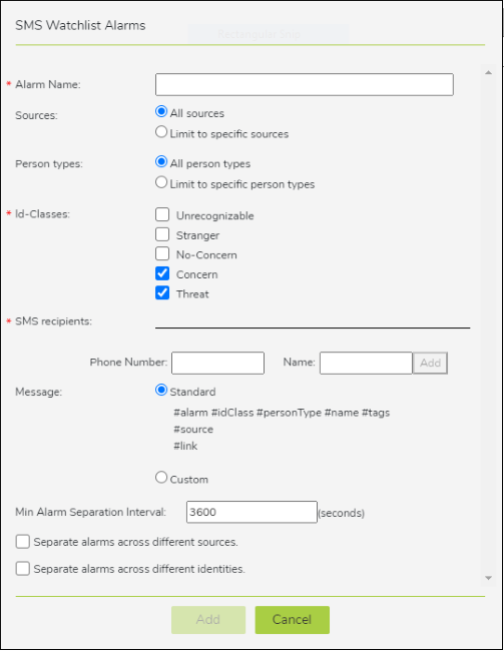1 SMS Watchlist Alarms Dashboard
The SMS Watchlist Alarms Dashboard allows you to create and manage one or more alarms that, when triggered, will send a Short Message Service (SMS) message to one or more specified recipients.
Before this dashboard can be used, you must first configure SAFR to send SMS messages. This is done on the Web Console's Status Page.
1.1 The Dashboard
When you click on the SMS Watchlist Alarms Dashboard on the Web Console's Reports Page, you're immediately shown the dashboard. For example:

The dashboard consists of a list of all the SMS Watchlist Alarms that you've defined. You're able to individually enable or disable the listed alarms. Clicking on a listed alarm will allow you to edit its definition. To define an entirely new alarm, click on the Add New Alarm button.
1.2 SMS Watchlist Alarm Definition
When you create a new alarm or edit an existing alarm, you'll use the alarm definition dialogue shown below to configure the alarm.

- Alarm Name: Name of this alarm. The name must be unique across all SMS Watchlist Alarms in the specified directory.
- Sources: Specifies which sources (i.e.which cameras) can be used to trigger this alarm.
- Person types: The Person types that can trigger this alarm. Note that in order to trigger this alarm, a person must also be one of the Id Classes specified below.
- Id Classes: The Id Classes that will trigger this alarm. Note that at least one Id Class must be selected.
- SMS recipients: The list of people (defined by their name and phone number) that will receive an SMS message if this alarm is triggered.
- Message: The text of the SMS message. You can select a standard message, or you can create a custom message of your own. Note that the SMS messages support macros, as shown in the table below. (Indeed, the standard message consists entirely of macros.)
|
Macro |
Description |
|
#alarm |
Will be replaced with the name of the alarm. |
|
#source |
Will be replaced with the event.source. If no event.source is set for the event, this macro will instead be replaced with an empty string. |
|
#site |
Will be replaced with the event.site. If no event.site is set for the event, this macro will instead be replaced with an empty string. |
|
#idClass |
Will be replaced with the event.idClass. |
|
#personType |
Will be replaced with the event.personType. If no event.personType is set for the event, this macro will instead be replaced with an empty string. |
|
#name |
Will be replaced with the event.name. If no event.name is set for the event, this macro will instead be replaced with an empty string. |
|
#tags |
Will be replaced with the event.tags. If no event.tags is set for the event, this macro will instead be replaced with an empty string. |
|
#link |
Will be replaced with URL to the event that triggered the alarm. |
Min Alarm Separation Interval: The amount of time, in seconds, that must pass before this alarm can be triggered again.
Separate alarms across different sources: When enabled, alarms triggered by different sources can ignore the Min Alarm Separation Interval value. (i.e.Multiple alarms can be triggered at the same time, provided each alarm is being triggered by an event viewed by different sources.)
Separate alarms across different identities: When enabled, alarms triggered by different people can ignore the Min Alarm Separation Interval value. (i.e.Multiple alarms can be triggered at the same time, provided each alarm is being triggered by a different person.)
1.3 See Also
- Traffic Dashboard
- Queue Dashboard
- Attendance Dashboard
- Traversal Dashboard
- Traffic Report
- Mask Detection Dashboard
- Events Map
- Operations Summary
- Operations Detail
- Occupancy Areas Editor
- Occupancy Dashboard
- Occupancy Alarm Dashboard
- Occupancy Report
Questions or comments about the documentation? Email us at safr-doc-feedback@realnetworks.com.
